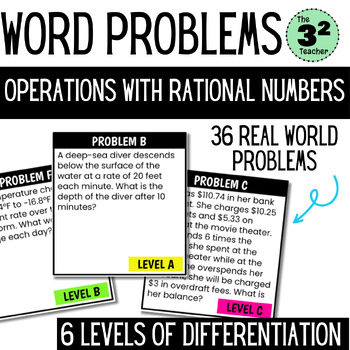Operations with Rational Numbers: Real World Word Problems Task Cards/Worksheets
- PDF
What educators are saying
Description
Available as a digital version and printable version.
Operations with Rational Numbers Word Problems is practice for students learning how to solve multi-step real world problems that include adding, subtracting, multiplying, and dividing with positive and negative whole numbers, fractions, and decimals.
There are 36 word problems with multiple levels of differentiation and a variety of contexts including money, elevation, temperature, time, and sports.
Levels
There are six levels of differentiation: three levels of problems with six problems included at each level. Each problem includes an extension for further differentiation.
Level A includes one-step word problems with integers then builds to two-step word problems with fractions and decimals in the extensions. Level B includes one-step or two-step word problems with fractions and decimals then builds to multi-step word problems with fractions and decimals in the extensions. Level C includes multi-step word problems with fractions and decimals then builds to more challenging multi-step word problems with unit rates, percents, and averages in the extensions.
Formats
The printable version includes two formats: color-coded task cards or worksheets.
All digital versions are editable so that you can customize to meet the needs of your students.
What Is Included
- Operations with Rational Numbers Word Problems Task Cards (Digital: Google Doc)
- Operations with Rational Numbers Word Problems (Digital: Google Doc)
- Operations with Rational Numbers Word Problems (Digital: Google Slides)
- Operations with Rational Numbers Word Problems (Printable: PDF)
- Answer Key
Questions and Feedback
Please feel free to reach out to me with any questions or with any feedback.
Thank you!





